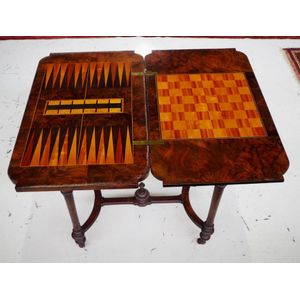Victorian Walnut Games Table with Inlaid Top and Swivel Board
You must be a subscriber, and be logged in to view price and dealer details.
Subscribe Now to view actual auction price for this item
When you subscribe, you have the option of setting the currency in which to display prices to $Au, $US, $NZ or Stg.
- Victorian Period - The Victorian period of furniture and decorative arts design covers the reign of Queen Victoria from 1837 to 1901. There was not one dominant style of furniture in the Victorian period. Designers used and modified many historical styles such as Gothic, Tudor, Elizabethan, English Rococo, Neoclassical and others, although use of some styles, such as English Rococo and Gothic tended to dominate the furniture manufacture of the period.
The Victorian period was preceded by the Regency and William IV periods, and followed by the Edwardian period, named for Edward VII (1841 ? 1910) who was King of the United Kingdom and the British Dominions and Emperor of India for the brief period from 1901 until his death in 1910. - Inlay - Decorative patterns inserted into the main body of a piece of furniture, generally in wood of contrasting colour and grain, though brass, ivory, ebony, shell and sometimes horn have been used. Inlay may consist of a panel of well figured timber inset into a cabinet door front, geometric patterns, or complex and stylized designs of flowers, swags of foliage, fruits and other motifs. As a general rule, in pieces where the carcase is constructed in the solid, the inlay is relatively simple such as stringing, cross banding and herringbone banding. Where more elaborate and decorative work was required veneer was used. Inlay has been fashionable from at least the latter half of the 17th century, when a variety of elaborate forms were developed
- Veneers - Veneers are thin sheets of well-figured timber that are glued under pressure to the surface of a cheaper timber for decorative effect, and then used in the making of carcase furniture.
Early veneers were saw-cut so were relatively thick, (up to 2 mm) but is was realised that saw cutting was wasteful, as timber to the equivilent of the thickness of the saw was lot on each cut.
A more efficient method was devised to slice the timber, either horizontally with a knife, or in a rotary lathe.
Flame veneer, commonly found in mahogany or cedar furniture, is cut from the junction of the branches and main trunk. So-called fiddleback veneers, where the grain is crossed by a series of pronounced darker lines, is usually cut from the outer sections of the tree trunk.
During the 17th and 18th centuries, and in much of the walnut marquetry furniture made during the latter part of the 19th century, the veneer was laid in quarters, each of the same grain, so that one half of the surface was the mirror image of the other.
The use of veneer allows many other decorative effects to be employed, including stringing, feather banding, cross banding, and inlaid decorative panels in the piece. The carcase over which veneer is laid is usually of cheaper timber such as pine, oak or, sometimes in Australia during the first half of the 19th century, red cedar.
The important thing to remember about veneers is that prior to about 1850 they were cut by hand, and were consequently quite thick - ranging up to about 2mm deep.
From the mid-19th century veneers were cut by machines and were almost wafer-thin. This is a critical point when trying to judge the approximate age of veneered furniture. - Foldover - A term used when describing card, tea or games tables, where the top folds over onto itself when not in use. The interior surfaces that are exposed when the top is open may be polished (in the case of tea tables) or baized (for card or games tables).
This item has been included into following indexes:
Visually similar items

A Magnetic chess set with table-top miniature table board. Provenance: The collection of the late Dr Thomas James Valentine

A Chinoiserie lacquer cabinet-on-stand, English with Eastern lacquer, first half of the 19th century, 149 x 99 x 46 cm

A William and Mary oak single drawer side table, turned legs joined by a shaped X-form stretcher ending in ball feet 130 x 66 x 73 cm

Hans Jorgensen Wegner (Danish, 1914-2007), Three Seater Sofa, Model Ge-236, designed c. 1953, manufactured by Getama, oak frame, upholstered in Kvadrat fabric, height 77 cm width 220 cm depth 78 cm. Provenance: Great Dane, Sydney, c. 2010. Private Collecti
